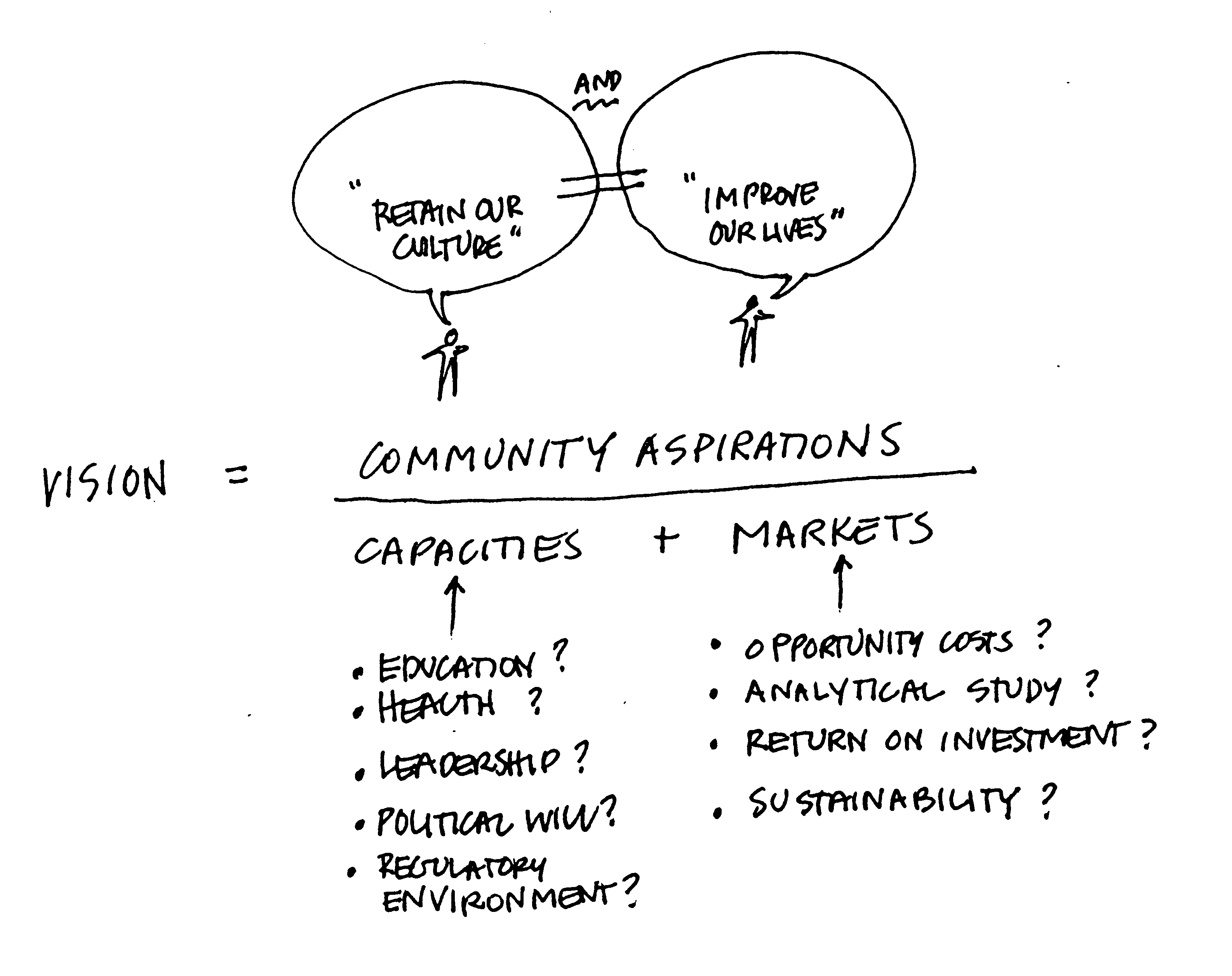
Mary C. Means
President, Mary Means & Associates
Turning Plans into Action: Collaborative Community Planning
PAPER SUBMITTED TO THE LEADERSHIP CONFERENCE ON CONSERVANCY AND DEVELOPMENT
September 1999, Yunnan Province, China
The thoughts I share with you today are shaped by my own experience in historic preservation and community development, gained by working with countless communities who seek to balance the need for change and improvement with the need for roots and traditions. I have learned that change cannot be halted, towns and cultures are always changing – or they are dying. The key issue is the pace of the change, and the potential to guide the change in ways that do not obliterate roots and culture in a rush to embrace the future.
We know that it is not enough just to save buildings, and that it is futile to try to preserve intact a culture’s traditions. Buildings from earlier generations have to be adapted to new uses and integrated into more modern cities. Similarly, cultural traditions and practices exist in a modern world, and are ever adapting to meet modern markets, modern needs.
Change is inevitable, the only questions involve the pace of change, and the efforts to understand it and guide it. And, as Undersecretary Cohen said in her remarks, we Americans do not come with answers. We do come with some experiences that may be useful.
The challenge posed to this conference is to build a sustainable program rooted in the impressive work done to date by the Joint Project on Yunnan Nationalities. The work of the Joint Project has been excellent and fundamental. It includes the kinds of basic activities that are often neglected, at least in my experience, such as surveys of craft skills and traditional arts, and creation of training and mentorship programs. It has not been easy, but you have accomplished an amazing amount in a short time. There is a sound basis of understanding what the assets are, what you have to build upon. And, there is a growing understanding of the threat to important cultural practices, to the cultural identity of many of the minority nationalities, unless steps are taken to guide the pace of change, to conserve and adapt those keystone elements of cultural life, arts and traditions that constitute identity in a rapidly changing world.
The next stage of the Joint Project on Yunnan Nationalities would seem to involve reaching out and forming new, expanded networks – convincing others, -- non-scholars, bureaucrats, political leaders at the national, provincial and community levels -- to support such efforts, to develop workable programs to implement the admirable new Yunnan provincial policies. The policy document is astonishing in its forward thinking. Embodied in it is a deep understanding of the need to re-define the end goal of government and society. The vision embodied in the Yunnan policies is not just to improve the economy. It is to improve the lives of people – people who seek a stronger economic future, but who also value the natural environment of their communities, and the cultural traditions that are so much a part of their identity. Achieving this exciting vision: a place that retains its culture while improving the lives of its citizens, will take much change from established practices. However, were Yunnan to achieve substantial success in implementing these policies, it would be a model for other nations, including my own.
My topic is community-based planning. The next stage of the Yunnan project involves a need to listen to each other with our minds in neutral gear, leaving our preconceptions aside. It involves a need to communicate, to learn and adapt old ways. Earlier this week, Prof. Chou used the term ‘mobilization of community-based action.’ That seems the heart of what lies ahead. My focus is on how.
My work in the US for two decades has centered on helping communities mobilize and take action, almost always involving achieving balance between holding on to important cultural anchors (buildings, neighborhoods, traditional practices, etc.) while embracing modern economic and cultural trends. Two principles are fundamental to my experience:
Vision

Vision is the articulation of a community’s aspirations, balanced with an understanding of the community’s capacities coupled with an understanding of market forces. Reaching these aspirations always involves change, sometimes radical change.
Human beings do not like change. At a brainstem level, we see change as a threat. Even considering the prospect of change creates stress and anxiety. And, as humans we have developed a whole menu of stress-avoidance practices. These include blaming others, dealing in personalities instead of issues, defining the problem narrowly and technically, then doing endless studies that lead no where, etc. Sounds familiar, doesn’t it? These are some of the ways we avoid having to deal with change.
To change, one must overcome the stress of the new, and adapt. How can this be done? Recent scholarly work at Harvard University has provided an exciting framework of theory that supports practical experiences, including my own. Harvard scholars have observed many practitioners, many leaders who have succeeded in community change. Their studies looked at leaders from many different fields, many different situations, including leaders who succeeded despite having had little formal authority or education.
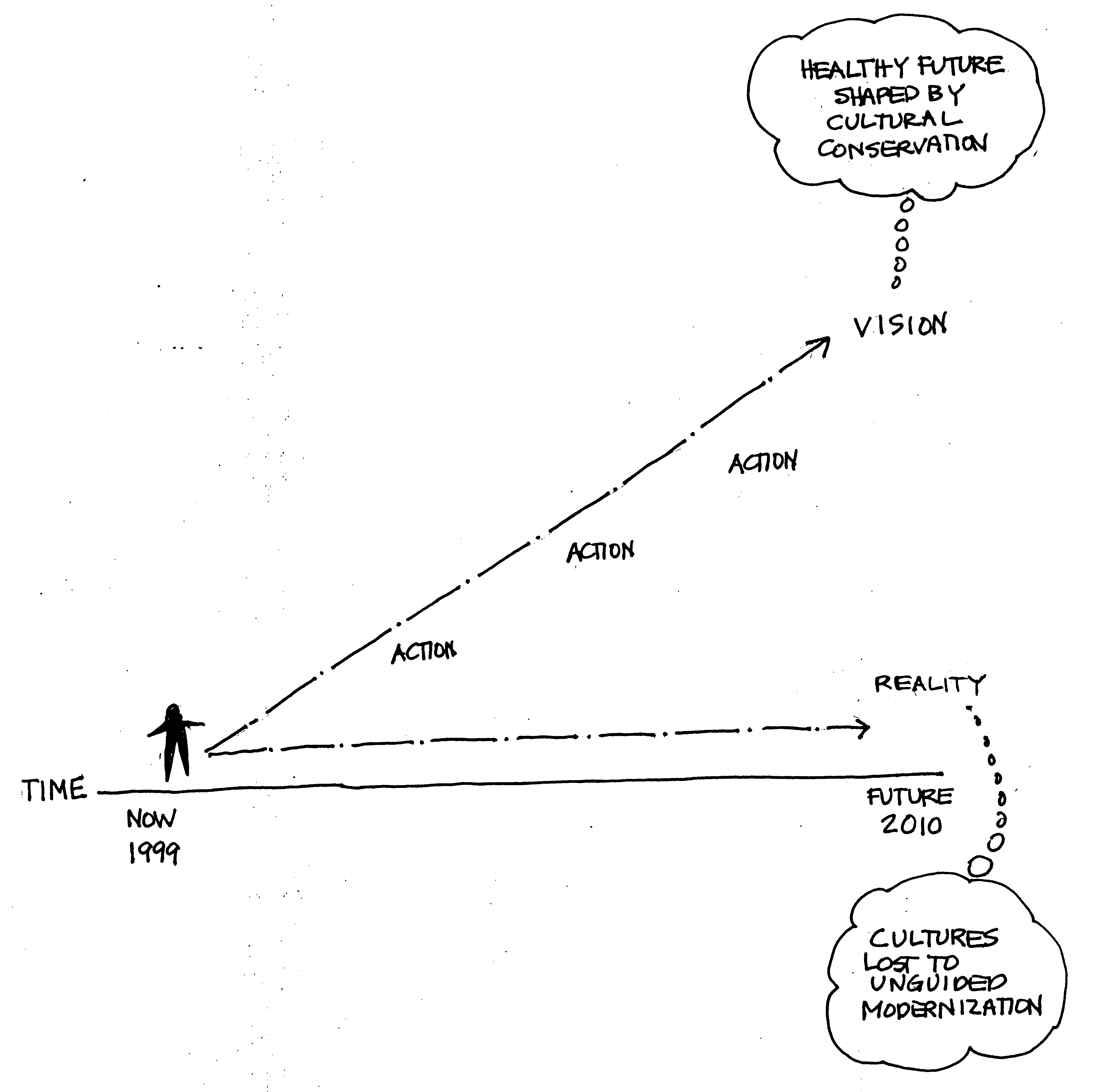
This diagram conveys the gap between a community’s vision, or idealized aspirations, and the reality of the challenges it must face in order to achieve them. To lessen the gap between the vision and the realities, one must take actions over time. Yet, taking action means change, and that is most often a prospect that is difficult. How do communities that manage to achieve needed changes accomplish it?
The experience of many communities that have navigated the challenges of change confirm the conclusions of the Harvard University studies. These studies have found that adaptation and the ability to change comes when people from many perspectives work on the problem or issue together in a safe environment, with some pressure applied -- a deadline or a reward, for instance -- to get them to stay at the task. If the stress of coping with change is acknowledged and managed, people can overcome their fears. They can gradually open their minds to hearing new information, to assessing it, to learning and thinking in new ways, ways that enable them to change and adapt.
The role of a leader in such a setting is to provide the safety and keep the pressure on just enough to keep people at the table, learning, sharing ideas and concerns, arguing, debating, adapting their perspectives. In doing so, the prospect of change becomes less threatening, the participants become more trusting of each other and are less stressed. They are more able to craft workable solutions that are systemic, not just short term or piecemeal.
Participation to foster comfort with change is often messy. It can be very stressful. But it is essential to achieve a sustainable plan supported by the commitments of those who must implement it.
Constituents
Who needs to be included? At the very least, the planning process needs to have the participation of respected representatives of every constituency needed to support the plan. Different people bring different perspectives and can add to the emerging plan in ways that make it more dynamic, more thought through. By listening to and addressing the concerns of people from many points of view, the plan’s authors can lessen the potential for unintended consequences during implementation. At the same time, the process of participation builds ownership and deepens the commitment for implementation.
However, participation and listening to other view points can be messy and difficult. This conference is an example. We come from very different cultures, we speak different languages, we think differently. Yet, we have found it exciting to share our ideas, to challenge our complacencies. Translators and interpreters have helped us bridge some of our differences.
One of the biggest challenges of participatory planning is the need to bridge cultures. Different cultures exist even in one country. The diagram [Diagram 3] illustrates the challenge and the benefit of participation in the planning by many people – from the earliest stage of defining the problem itself.
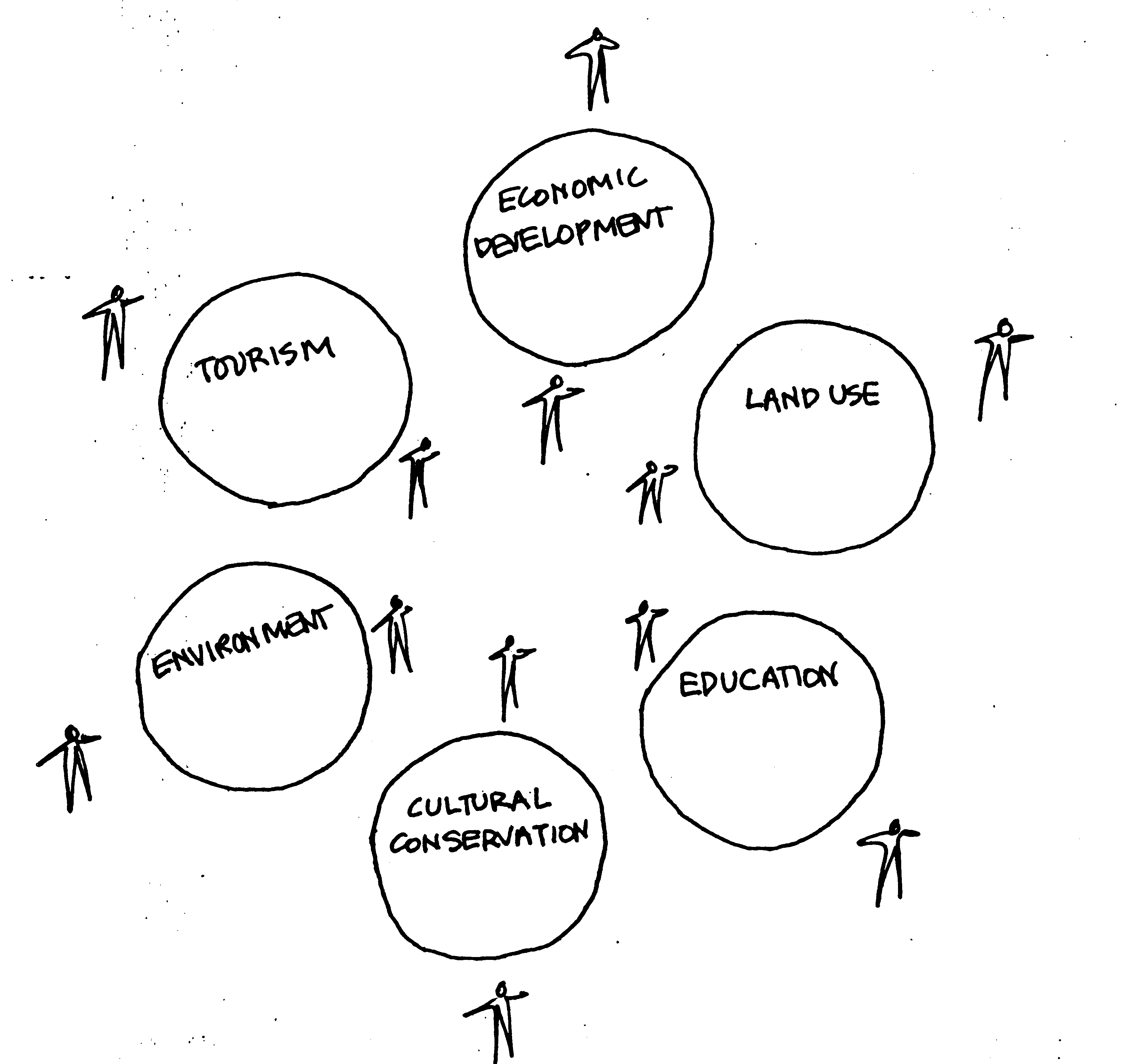
Each of these circles is occupied by a different culture. In this case it is professional or ‘interest’ cultures, but it could be nationalities or provinces, even age groups. The ‘language,’ the values, the personalities of professionals in each of these fields are quite different. For instance, the culture and ‘world view’ of people who work in tourism is quite different from the culture and ‘world view’ of environmentalists. Each of these cultures has its own language, values, ‘morality,’ – and perceptions of the other cultures.
Each of the cultures
has within it people who are open to new ideas, to cross-cultural experiences.
They are symbolized by the figures on the inside of the circles, able to reach
out to the others. But there are always – in every culture – those people who
are resistant to change, represented by the figures on the outer edges of the
circles. Somehow, those who are able to reach across to other cultures and explore
change have to be provided the opportunity to do so in ways that balance the
tension created by those on the outer boundaries who fear change – and are often
quite vocal. The value of a well-designed and managed participatory planning
process is that it affords the opportunity for all voices to be heard, in an
environment that is safe for listening, learning and dialogue to take place.
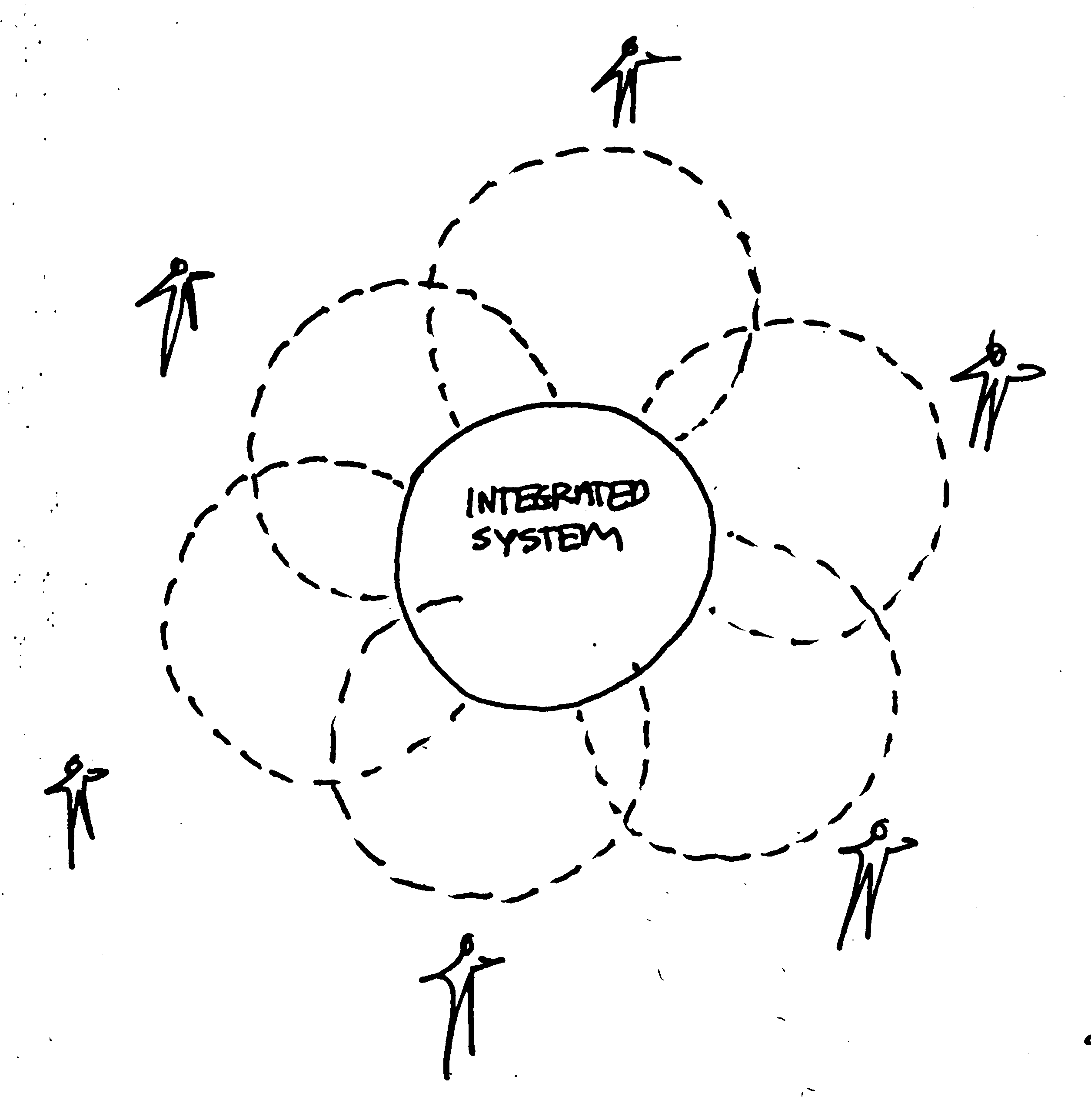
A participatory planning process allows collaboration to occur, cross-over thinking to happen, and from that emerges a brighter, stronger plan of action that enjoys a broader constituency, that has a far greater prospect to contain a systemic approach where the sum is greater than the parts.
Process
What is the setting? How can such cross-over take place?

In our work in the U.S. we often use the metaphor of the table. Tables of power. We hear people say, "I cannot get a place at the table. Power-holders hold all the seats. I am left out." Disenfranchised people may even think, "You may leave me out, but I will get even, I will resist." Getting a seat at the table is not possible. And, those who try to take a seat at a table of power are viewed as a threat to the established power structure.
A community-based participatory planning process usually involves a group of constituents who meet regularly in a safe, contained, facilitated setting. It is in this group that the adaptive learning and planning for change takes place. However, the process is more than just about planning. To continue the table metaphor, If such a group is also viewed as a temporary table of power, there is great opportunity to set the scene for constructive change, for turning the plan into action. There is even the opportunity later to groom or mentor some of those at the temporary table, and move them into the community’s more permanent power tables.
Seated at the temporary table must be some of the community’s respected venerable holders of power. Also at the table should be others who bring fresh insights, local wisdom, neglected perspectives. Working together in a facilitated process over time (but not too much time, for momentum is very important), the group learns to trust each other. They learn to listen to others, to debate, to respect each other’s views – and then make decisions in ways that make greatest sense because they are based on the shared perspectives rather than just individual ones. This way, adaptive learning takes place.
How do the people
at the table actually work? How can participation be managed to encourage all
voices to be heard, none to dominate? How can highly educated scholars, decisive
business leaders, government bureaucrats, grassroots people dialogue together,
learn to listen in new ways? How can the messiness of it all be contained so
a plan emerges and leaders are motivated to take action? We are experiencing
it here in this conference, although our time is too brief to do more than begin
a long exciting journey. Nearly every speaker has emphasized the critical need
for participatory, inclusive, grassroots approaches for balancing conservancy
and development.
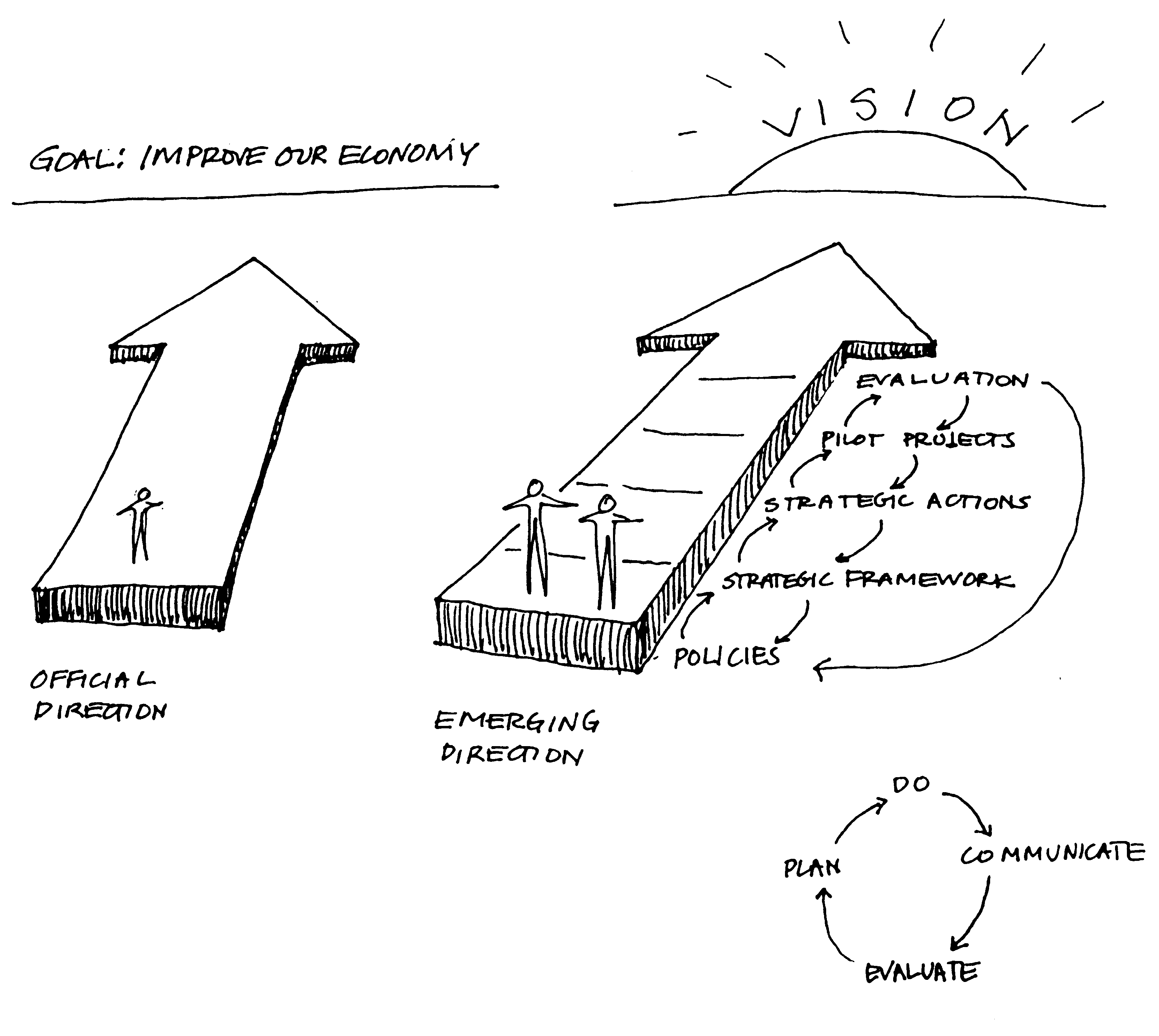
During the last forty years, in Europe, North America and Asia, many practitioners have been adopting more participatory, interactive ways to plan and make decisions, decisions that are supported by the community and lead to action. New ways of working together have emerged in many other endeavors besides cultural conservancy. Yunnan can learn much from them. There is a huge body of work, many publications, much training available to help modern leaders engage in this participatory way with their constituencies. These methods and approaches can be adapted to mobilize sustainable action. That body of work is available for the next stage of this important project in Yunnan.
Notes:
The Harvard University studies are contained in Ronald A. Heifetz, Leadership Without Easy Answers, Harvard University Press, Cambridge MA, 1994. The book can be ordered from www.amazon.com.
Mary C. Means is
president of Mary Means & Associates, Inc., a community planning firm whose
practice areas include: downtowns & city neighborhoods; heritage regions
& byways; visioning & comprehensive planning; consensus building &
strategic planning. She can be reached at mmeans@marymeans.com.